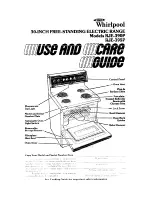
18
USSC
SETTING THE DRAFT
A proper draft setting is crucial to the successful burning of solid fuels. Draft refers to the amount of air flowing through the
burn chamber of your stove. Too much or too little draft will cause your stove to burn improperly and may result in the fire
burning out or excessive deposits (clinkers). Please follow these guidelines carefully as you operate your stove to achieve
maximum efficiency and enjoyment.
•
•
•
•
•
The amount of draft required for your stove to burn properly will depend upon your installation and the fuel you use. You
can set your draft by looking at the flame and following these guidelines. The manual draft knob is the rod and knob on
the left side of the stove. Pulling the knob out increases the draft and pushing the knob in decreases the draft. A little
movement of the knob goes a long way to changing the flame. It may take several trial and error adjustments on the
draft to achieve the correct setting.
The flame should be an “active” flame. A flame that moves around lazily and emits visible smoke needs more draft. To
give the fire more draft, pull the damper out
1/8”
and check the flame again. If the status of the flame has not changed,
move damper another
1/8
” until you get a clean “dancing” flame.
The base of the flame should be blue in color and the top of the flame should be yellow.
If the flame does not have enough draft, fuel will build up in the firepot and eventually smother the flame. If this
happens, or if you notice the firepot is filling up with partially burned fuel, open the damper
1/8
” at a time until the fire is
clean and dancing.
If the flame has too much draft, the flame will look like a torch in that it will be moving rapidly and blowing fuel out of the
firepot. If you find that you have this condition, move the damper inward 1/8” at a time until the condition of the flame
changes.
MAINTENANCE INSTRUCTIONS
•
•
•
•
•
•
Surfaces on the front of the stove will be extremely hot during operation.
Always wear heat resistant gloves
to perform periodic maintenance.
Using a wooden stick, tap the side heat exchangers that are located on the left and right sides of the firebox. When you
open the door, they are located directly inside to the left and right. When you tap the sides with the wooden stick the
loose fly ash will drop out of these holes.
Pull the lower front ash clean-outs out and scrape any fly ash down into the pedestal ash pan. Push them back in all the
way.
While you are tapping the side heat exchangers, we recommend that you pull the draft knob all the way out for a minute
or two and put the unit on high fire. This will allow the unit to self-clean the heat exchanger area, the draft fan and
exhaust chimney pipe.
If clinkers develops in the firepot, remove with a scraper. You may have to do this once or twice a day depending on the
moisture content of the corn. If this is not cleaned out, it could cause the fuel stirrer to jam. Clinkers are a direct result
of excessive corn moisture, or excessive air, and do not indicate a problem with the stove. USSC highly recommends an
additive (mentioned on pg. 21) be added to your corn to eliminate these clinkers. Contact your local Feed and Seed for
availability and cost. You will need this additive if the agitator “fingers” develop an accumulation or build-up.
Open the stove doors and wipe the inside of the glass with a damp cloth as needed.
Daily Maintenance
Soot and Flyash - Formation and Need for Removal
The products of combustion will contain small particles of flyash. The flyash will collect in the exhaust venting system and
restrict the flow of flue gases. Incomplete combustion, such as occurs during startup, shutdown, or incorrect operation of
the room heater will lead to some soot formation which will collect in the exhaust venting system. The exhaust venting
system should be inspected at least once per month (of heavy use) to determine if cleaning is necessary.
Summary of Contents for American Harvest 6035
Page 25: ...USSC 25 WIRING DIAGRAM...











































